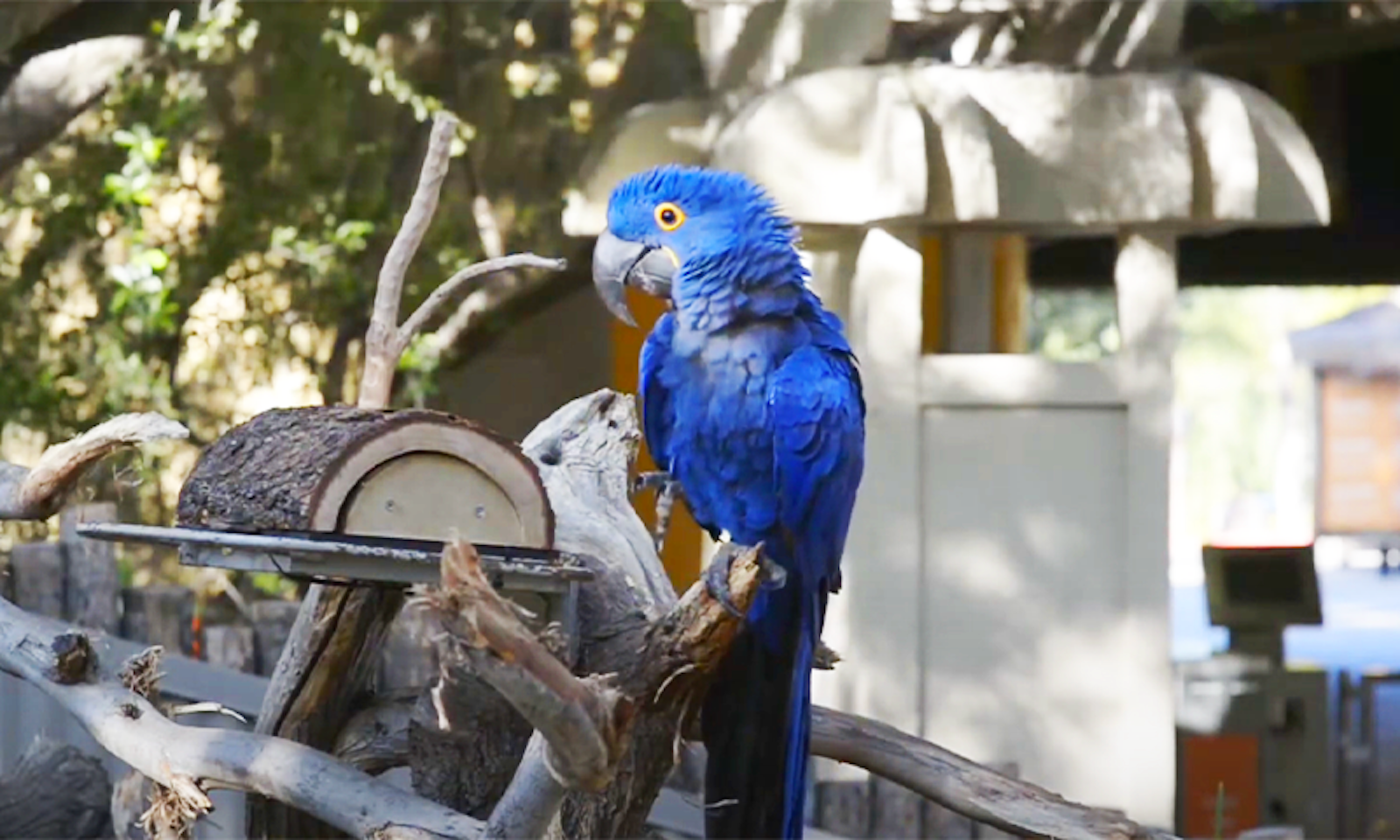In a modest rectangular enclosure surrounded by sparse green shrubbery, just past the main gate of San Diego Zoo Safari Park, a middle-aged hyacinth macaw blasts Daft Punk on his bespoke boombox. His name is Sampson and he likes to dance.
Sampson can operate the boombox, aptly named JoyBranch, by biting or holding on to a kind of joystick made to look like a slice of log with a twig protruding from it. Motion sensors (called BobTrigger) keep the music going as long as he bobs and nods, dipping his head in rhythm. Within weeks of its installation, the boombox changed the dynamics of Sampson’s interactions with visitors. To draw them in, he could rock out. When he tired of entertaining, he could stop dancing to switch off the music. More often than not, when the show was over, his visitors moved on.
It’s really about rethinking the culture of zoos.
JoyBranch is one of a number of sound projects at San Diego Zoo and other zoos around the country that aim to give captive animals more agency over their environments. The boombox came into being after Sampson’s caretakers noticed how much the bird enjoyed grooving to the rhythms wafting from an iPhone during care sessions. (The BobTrigger was added when they realized he couldn’t press play on the JoyBranch and dance at the same time.)
The project was led by Rébecca Kleinberger, a digital technology, cognition, and sound researcher trained in MIT’s Media Lab who now runs her own research group at Northeastern University in Boston. When Kleinberger walks through a zoo, she doesn’t just look, she listens. Here is the cackle of families laughing and talking as they walk by, a gasp of excitement as an animal turns to face them, a child’s piercing cry for attention. Then the sound wave of human noise retreats as the crowd moves on, and she can suddenly detect the roar of a male lion in the distance. It is a deep, penetrating, regal growl that visitors delight in. But how does it make the gazelle standing just a few feet away from her behind the slim barrier feel? The animal is evolved to feel fear.
In her work with zoos, Kleinberger aims to use sound to reduce the stress of animals living there, to improve their quality of life and, most of all, to give them some control over their environments. Hearing is a dominant sense for many species, and animals in zoos are continuously bathed in sounds that may have little in common with what they might hear in the wild: construction noise, vehicles, human speech, and the sounds of unfamiliar animal neighbors. Sensitivities vary from species to species but some animals suffer from discomfort severe enough to provoke pacing, rocking, and self-harming behaviors, like plucking out their own feathers.
“It’s really about rethinking the culture of zoos,” says Kleinberger. Sometimes the kind of intervention she recommends is simple, like providing a soundproof space for an animal to access when needed. But sometimes it’s about adding sounds, rather than removing them. “There are ways of thinking more innovatively, more creatively, into what we can provide for animals” to enrich their lives in captivity, she says. In a review published last month, Kleinberger laid bare her vision for the “zoos of the future”—a manual for how to incorporate thoughtful soundscapes into their design.
It is a deep, penetrating, regal growl that visitors delight in.
Only about one-third of zoos have actually experimented with auditory enrichment—including natural and ecologically relevant sounds, human-made classical music, and radio broadcasts—to enhance the welfare of captive animals. Asian elephants, leopards, and several species of birds have been shown to benefit, according to the research. A much smaller number of projects in zoos have allowed captive animals to actually interact with sounds, including experiments with macaws, white-faced sakis, African elephants, and orangutans. Orangutans, for example, have been encouraged to create their own “music,” though some research suggests the apes may often prefer silence to sound.
When Sampson played his music, he did it for his own enjoyment, but also to entertain an audience. During a 2020 study of how Sampson used JoyBranch, together with colleagues, Kleinberger reported that when no music was playing visitors walked away from Sampson even as he was trying to engage with them. In his role as DJ and performer, however, using JoyBranch, he held court, and was the one to decide when to begin and end the show. The visitors were delighted—we come to zoos to connect and observe animals. The best time at the zoo is when we walk away feeling the animals are not sad to be there.
As we walk through a zoo, we often forget that we too are on display for the animals to observe. Being present with animals in these spaces presents rare opportunities for interaction. Kleinberger believes that technologies can help make these interactions more meaningful for us and the animals, enriching the zoo experience. “I don’t think it’s good to think about the animal in isolation, but much more in terms of how do we integrate the humans” she says. “I’m into creating experiences and creating live connections between spaces, between people, between animals.” ![]()




























